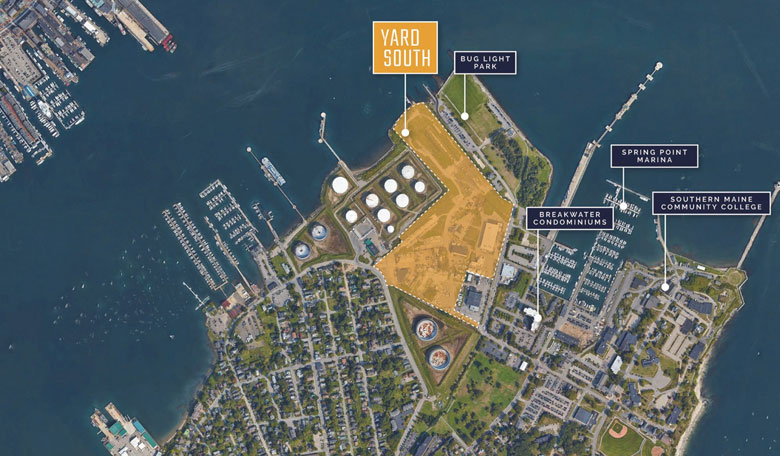The plan by a California land developer to convert the former shipyard at Cushing’s Point where Liberty ships were built during World War II into a 30-acre “mixed-use neighborhood” including as many as 1,000 residential units is creeping forward in the face of substantial opposition from many in the South Portland community.
New York City investor John Cacoulidis acquired the former shipyard in 1991. Three years later, the city of South Portland acquired just under 14 acres of the site to create Bug Light Park. A decade after that, Cacoulidis proposed developing the site with a couple of high-rise hotels and housing but that proposal, facing strong opposition from the South Portland community, died.
In 2018, L& R Northpoint Holdings, LLC, bought the land from the Cacoulidis family for $7.7 million and hired PK Realty Management to “operate, manage and lead the development” of the property.
About four years later, in 2022, PK, acting as the agent of L&R Northpoint, filed a pre-application with the city for a zoning change which, according to the company’s website, “brings the site into alignment with the city’s 2012 comprehensive plan” that “envisions this underutilized industrial land as a place for people to live, work, and enjoy the waterfront.”
“We support keeping the shipyard zoning for maritime uses. They’re much more appropriate to the area…”
—Cathy Chapman of No Yard South
On its website, PK asserts that while current zoning doesn’t allow housing, the comprehensive plan “envisions a mixed-use zone that includes residential” use.
On July 31, PK filed contract zone and zoning map amendment applications for the waterfront site located at the end of Broadway and sandwiched between Bug Light Park and a tank farm storing petroleum products. Nearby are the Spring Point Marina and the Breakwater Condominiums.
The contract zoning provisions, and the map, describe precisely what uses would be permitted on the site and how PK intends to develop the project known as “Yard South.”
On its website, PK says the goal of the project is to establish “a mixed-use neighborhood” that would include “retail, commercial, industrial, community services,” provide access to the Fore River waterfront, and incorporate about 1,000 residential units.
Some of those units would be in buildings substantially taller than permitted under the current zoning which allows for buildings of approximately eight stories. According to PK, 100 units would be dedicated to “affordable housing,” in partnership with the City’s Housing Authority.
No surprise, Yard South has generated substantial opposition in the South Portland community. Cathy Chapman, organizer of the group known as No Yard South, said that though she favors residential development in South Portland, the former shipyard site was a bad choice for housing.
“We support keeping the shipyard zoning for maritime uses,” Chapman said. “They’re much more appropriate to the area and more resilient to sea rise.”
Chapman said the proposed Yard South development was also inappropriate for residential use because of the presence of contaminated soil on the site dating back to its shipbuilding days.
Another group, Protect South Portland, claims the Department of Environmental Protection found evidence of benzene—a known carcinogen—in the vicinity of the site. The level of fumes, possibly emanating from the tank farm bordering the Yard South site, were higher than maximum safe levels set by Maine’s Ambient Air Guidelines.
The proximity of the tank farm also means, according to Protect South Portland, that an emergency evacuation plan would also be necessary for Yard South residents in the event of a spill, fire, or other problem at the storage facility.
Chapman also mentioned the need for an evacuation plan in the event of extreme flooding events which will likely become more frequent with climate-driven sea level rise.
A related problem, Chapman said, is the traffic that the addition of 1,000 housing units will put on South Portland’s already traffic-choked roads. She said the developers call for road improvements in their plans but have left the burden of paying for those improvements on city taxpayers. The costs of adding schools to service the population of the new residential units, she said, was also left to the taxpayers.
In September, the city delivered a 20-page “completeness review” of Yard South’s contract zoning application filed earlier in the summer to the developer. The review determined that the application was incomplete and set out a list of questions and clarifications to which the developer will have to provide detailed answers before the city can proceed with its review.
The letter addresses issues of sustainability, school, traffic, and public safety impacts as well as calling for more precise specifications for site design and proposed uses. No date for a response was mentioned.
With so many issues still to be resolved, Chapman said, No Yard South has asked the South Portland City Council to schedule a formal, public workshop on the requested zoning changes at which the organization will be allowed to present a detailed explanation of the grounds for its opposition to the massive development. In September, an informal community meeting organized by the group drew an audience of more than 100, Chapman said.





